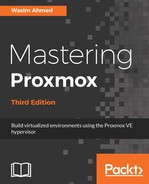The VLAN-aware checkbox is a new addition that allows Proxmox to act as a trunk in a switch that will pipe multiple VLANs over one connection. Although it is not important to enable it, however, it is a new way of handling VLANs on the bridge. For example, if we need to implement 10 VLANs, we will need to create 10 virtual bridges in the traditional Linux bridge way. However, using the VLAN-aware option, we can create one bridge and just add the VLAN ID to it, thus saving a lot of time typing out multiple bridge configurations.
The following shows a basic example configuration of a traditional Linux virtual bridge for 10 VLANs:
auto vlan0
iface vlan0 inet manual
vlan_raw_device eth0
auto vmbr0
iface vmbr0 inet manual
bridge_ports vlan0
bridge_stp off
bridge_fd 0
..........
..........
auto vlan10
iface vlan10 inet manual
vlan_raw_device eth0
auto vmbr10
iface vmbr10 inet manual
bridge_ports vlan10
bridge_stp off
bridge_fd 0
In the preceding configuration, we can see that there are a lot of bridge instances in the traditional Linux form. However, using the VLAN-aware option, we can reduce the entire configuration to just a few lines. The following is an example configuration of a VLAN-aware bridge for 10 VLANs:
auto vmbr0
iface vmbr0 inet manual
bridge_vlan_aware yes
bridge_ports eth0
bridge_vids 1-10
bridge_pvid 1
bridge_stp off
bridge_fd 0
The advantage of using the traditional Linux method is that each VLAN gets its own virtual bridge, thus isolating the network traffic further. For instance, when reconfiguring a bridge of a particular VLAN ID, only that bridge and all the VMs connected to that bridge are affected. For the VLAN-aware mode, when there is a misconfiguration, it can interrupt network connectivity for all the VMs connected to the bridge. The VLAN-aware mode provides similar functionalities as Open vSwitch but without the extra package. We will learn about Open vSwitch later in this chapter.
When using the VLAN-aware bridge, we have to tag each virtual interface with the VLAN ID, as shown in the following screenshot:

When using traditional mode without the VLAN-aware option, we have to select the VLAN tagged bridge itself instead of entering the VLAN Tag for the virtual network interface.
